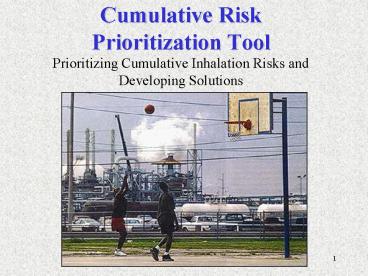Cumulative Risk Prioritization Tool PowerPoint PPT Presentation
1 / 16
Title: Cumulative Risk Prioritization Tool
1
Cumulative Risk Prioritization Tool
- Prioritizing Cumulative Inhalation Risks and
Developing Solutions
2
Community Issues
- Is the air I breath safe?
- Is the water I drink safe?
- Is the food I eat safe?
- It is possible to have facilities/geographic
areas meeting all state and Federal rules yet
still have unhealthy air?
3
Regional Air Impact Modeling Initiative (RAIMI)
- Region 6 developed a tool to answer these
questions - Assesses community-level inhalation impact
- Can evaluate an unlimited number of stationary
and mobile sources
4
Regional Air Impact Modeling Initiative (RAIMI)
- Whats different from past efforts?
- Attributes impact back to individual compounds
and individual emission sources - Serves as platform for strategic and tailored
environmental actionsfacilitates solutions
5
What is the level of expertise and effort
required?
- Knowledge of emissions data
- Expertise in air dispersion modeling
- Understanding of model sensitivities
- Understanding of risk results
6
How Accurate is this?
- Emissions inventories vary in completeness/data
quality - Source locations are critical and often incorrect
in inventories - Simple exposure scenarios utilized 30 year, 350
day, outdoor - Process upsets usually not included or
characterized - Air dispersion/risk model consistency
- Comparison to air monitors for pilot study have
indicated predicted results within 20 of
monitored results
7
Example Case Study Port Neches, Texas
- History
- CEP shows Jefferson County, as having the highest
potential for exposure in Region 6 - Context
- 16 Major industrial facilities
- 1,500 Point source emissions
- 82 Area and mobile source categories
- 188 HAPs
- Findings
- Identified and prioritized 2 facilities
- Identified and prioritized 5 point sources
- Identified local data gaps
- Prioritized 1 area and 2 mobile emission source
categories
8
Define Assessment Scope County vs. Community
Level Resolution
9
Results Transparency to Support Prioritization
Groves
Beaumont
Jefferson County, Texas Cumulative Inhalation
Cancer Risk Profile for Residential Area
Nederland
10
Results Resolution to Support Prioritization and
Verification Source Attribution Profiling (Zoom)
Identified source was shared with TCEQ, source
impacts validated by mobile monitoring, solution
(covering wastewater impoundment) was negotiated.
Jefferson County, Texas Cumulative Inhalation
Cancer Risk Profile for Residential Area
11
Results Resolution to Support Verification and
Legal Review Source Attribute Tracking (Sample)
Source Attribute Table
Source Attribute Table
JE0017A
Account No.
JE0017A
Account No.
Ameripol Synpol Corp.
Account Name
Ameripol Synpol Corp.
Account Name
WasteWater
Site Name
Trap 4 XS99
Site Name
Waste water system
Facility Name
ETF Styrene Tank
Facility Name
Fugitive
Source Type
Tank Sector 9989A
Plant ID
WTWTR DISCH TO RT
Point Name
NE1
Point Name
JE0F011
Unique Pt Name
JE0F00M
Unique Pt Name
Wastewater
EPN
T-ESTY
EPN
F-WWATER
FIN
TANKS-ESTY
FIN
RCRA Permit No. 988A
Permit Status
RCRA Permit No. 988A
Permit Status
--
SIC Code
--
SIC Code
Bob Smith 222-222-2222
Facility Contact
Bob Smith 222-222-2222
Facility Contact
Emissions Profile (TPY)
Emissions Profile (TPY)
Actual Allowable
Actual Annual
Contaminant
Actual Allowable
Actual Annual
Contaminant
N/A
11.87
1,3-Butadiene
N/A
1.78
1,3-Butadiene
N/A
11.42
Styrene
N/A
0.67
Styrene
12
How to Use Results
- Conduct Risk-Based Prioritizations
- Complements National-Scale Assessments
- Identify Risk Trends
- Determine Significance of Data Gaps
- Track Emissions Reduction Efforts
- Support Monitoring Programs
13
RAIMI COMPONENTS
Example Population Maps Ethnicity
14
Nighttime Population Distribution
Land Scan USA Population Data Diurnal
population distribution is critical to
understanding the localized nature of exposure.
More than 160,000 people occupy this downtown
tract during a typical workday. The same area is
almost deserted during nighttime hours.
Daytime Population Distribution
15
Population and Risk Averaging
16
Summary
- Focus is on identifying individual sources for
targeted reductions, not simply identifying areas
of concern - Initial findings a small number of sources/
chemicals result in majority of impact

